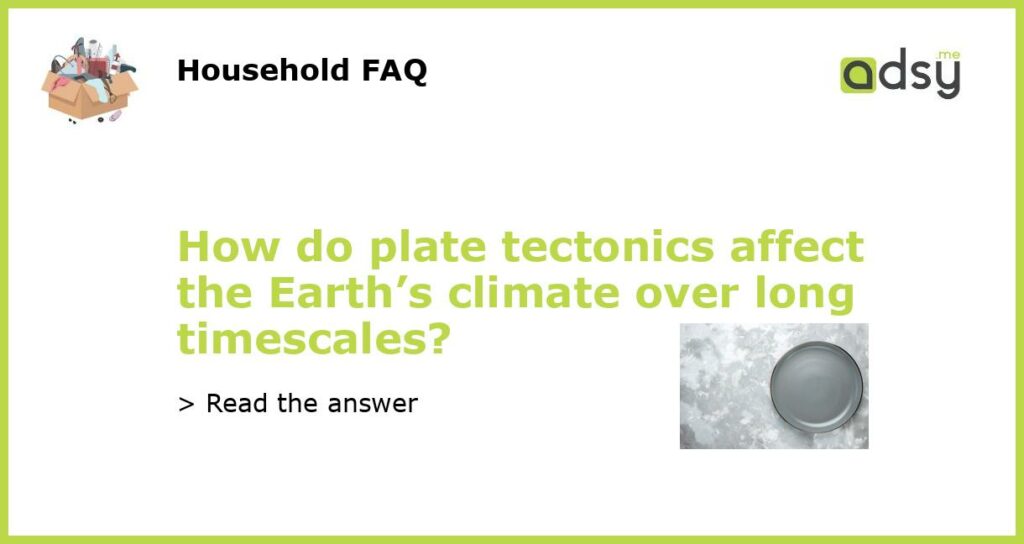Plate Tectonics and the Earth’s Climate
Plate tectonics is the scientific theory that describes the movement and interactions of large sections of the Earth’s lithosphere. These tectonic plates may include continental crust, oceanic crust, or a combination of both. While plate tectonics primarily affects geological processes such as the formation of mountains and earthquakes, it also has a significant impact on the Earth’s climate over long timescales. Here’s how plate tectonics affects the Earth’s climate:
Continental Drift and Climate Change
One of the key aspects of plate tectonics is the concept of continental drift. Over millions of years, tectonic plates can move and cause continents to shift their positions. This movement has far-reaching effects on the Earth’s climate. When continents are located near the equator, they receive more solar radiation, resulting in warmer temperatures. Conversely, when continents are located closer to the poles, they receive less solar radiation, leading to cooler temperatures. The movement of continents due to plate tectonics can drastically change the distribution of landmasses on Earth, influencing global climate patterns.
Influence on Ocean Currents
Plate tectonics can also impact ocean currents, which play a crucial role in regulating the Earth’s climate. The movement and collision of tectonic plates can create or alter oceanic ridges and basins, directly affecting the circulation of water in the oceans. For example, the formation of the Isthmus of Panama, which connected North and South America, dramatically changed the exchange of water between the Atlantic and Pacific Oceans. This change in ocean circulation had significant implications for global climate patterns, including the onset of the Ice Ages.
Volcanic Activity and Climate Effects
Plate tectonics is closely linked to volcanic activity, as most volcanoes are formed near plate boundaries. Volcanic eruptions release large amounts of gases and particles, including carbon dioxide (CO2), sulfur dioxide (SO2), and ash, into the atmosphere. These emissions can have both cooling and warming effects on the Earth’s climate. While volcanic gases can act as a greenhouse gas, trapping heat and leading to warming, sulfur dioxide can form sulfate aerosols that reflect sunlight back into space, causing cooling. The frequency and magnitude of volcanic activity influenced by plate tectonics can thus impact the Earth’s climate over long timescales.
Uplift of Mountains and Climate Changes
The collision of tectonic plates can also result in the uplift of mountains, such as the Himalayas. The formation of these mountains can have significant effects on regional and global climate patterns. Firstly, mountains can obstruct the flow of air masses, leading to the formation of rain shadows. This phenomenon occurs when moist air is forced to rise over mountains, resulting in precipitation on one side and arid conditions on the other. Secondly, mountains can influence the distribution of rainfall, causing variations in temperatures and creating diverse ecosystems. Therefore, plate tectonics can indirectly impact climate through the uplift of mountains.
Long-term Climate and Tectonic Feedbacks
Lastly, plate tectonics can generate long-term climate feedbacks. For example, the process of weathering, where rocks break down into smaller particles, is influenced by tectonic activity. Weathering plays a crucial role in the carbon cycle, as it helps remove carbon dioxide from the atmosphere and store it in rocks and sediments. Over millions of years, the weathering of rocks can regulate the levels of atmospheric CO2, which is an important greenhouse gas that influences the Earth’s climate. This feedback between plate tectonics, weathering, and atmospheric CO2 levels can have profound effects on the Earth’s climate over geological timescales.
In conclusion, plate tectonics has a significant impact on the Earth’s climate over long timescales. Continental drift, influence on ocean currents, volcanic activity, uplift of mountains, and long-term climate feedbacks are some of the ways in which plate tectonics affects climate. Understanding these interactions is crucial for comprehending past climate changes and predicting future climate scenarios.






